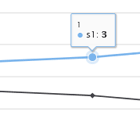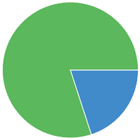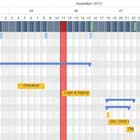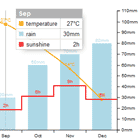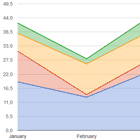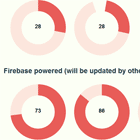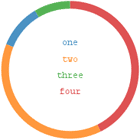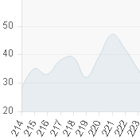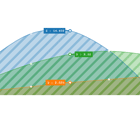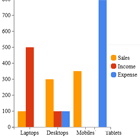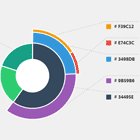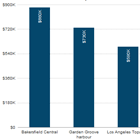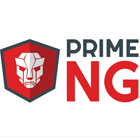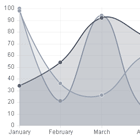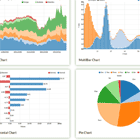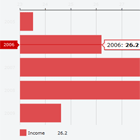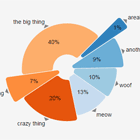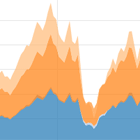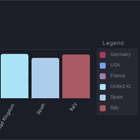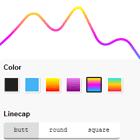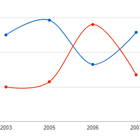⚠️ Not supported anymore.
Consider using the offical Highcharts wrapper for Angular
angular2-highcharts
Highcharts chart components for Angular apps.
👉 Live Demo
Table of Contents
- Setting Up
- Install angular2-highcharts
- Setup App @NgModule
- Usage
- Basic Usage
- Handling Events
- Dynamic Interaction with Chart Object
- Highstock
- Highmaps
- Add Highcharts Modules
- Access to the Highcharts Static API
- More Examples
- FAQ
- License
Setting Up
Install angular2-highcharts
npm install angular2-highcharts --save Setup App @NgModule
import { NgModule } from '@angular/core'; import { BrowserModule } from '@angular/platform-browser'; import { ChartModule } from 'angular2-highcharts'; import { App } from './App'; @NgModule({ imports: [ BrowserModule, ChartModule.forRoot(require('highcharts')) ], declarations: [App], bootstrap: [App] }) export class AppModule {}For angular-cli and other Webpack environments
No any additional setup needed
For SystemJS environment
You should add appropriate mapping to your systemjs.config.js
... map: { ... 'angular2-highcharts': 'node_modules/angular2-highcharts', 'highcharts': 'node_modules/highcharts', } ... packages: { ... highcharts: { main: './highcharts.js', defaultExtension: 'js' }, 'angular2-highcharts': { main: './index.js', defaultExtension: 'js' } }Usage
Basic Usage
Create First Chart Component
Main charts functionality provided by the chart component and its options property.
import { Component } from '@angular/core'; @Component({ selector: 'simple-chart-example', template: ` <chart [options]="options"></chart> ` }) export class App { constructor() { this.options = { title : { text : 'simple chart' }, series: [{ data: [29.9, 71.5, 106.4, 129.2], }] }; } options: Object; }Handling Events
Highcharts itself provides bunch of events, and you still can use them with angular2-higcharts via the options property of the chart component. But it is not an angular way to handle events like this. So that angular2-higcharts provides EventEmitter<ChartEvent> wrappers for highcharts events. ChartEvent is an angular2-higcharts class which simply wraps original Highcharts events (chartEvent.originalEvent) and adds event handler context (chartEvent.context) since it differs depending on events.
Chart Events
All the events from the options.chart.events are available as output properties of the chart component.
<chart [options]="options" (selection)="onChartSelection($event)"> </chart>onChartSelection (e) { this.from = e.originalEvent.xAxis[0].min.toFixed(2); this.to = e.originalEvent.xAxis[0].max.toFixed(2); }Series Events
To use series events the same way you need to add the series component as a child of your chart. The only purpose of this auxiliary component is to provide access to options.plotOptions.series.events API
<chart [options]="options"> <series (mouseOver)="onSeriesMouseOver($event)"> </series> </chart> <p><b>{{serieName}}</b> is hovered<p>onSeriesMouseOver (e) { this.serieName = e.context.name; }Point Events
Similary you can use the point to access to options.plotOptions.series.point.events API.
<chart [options]="options"> <series> <point (select)="onPointSelect($event)"></point> </series> </chart> <p><b>{{point}}</b> is selected<p>Axis Events
Similary you can use the xAxis or yAxes to access to options.xAxis.events or options.yAxis.events API.
<chart [options]="options"> <xAxis (afterSetExtremes)="onAfterSetExtremesX($event)"></xAxis> <yAxis (afterSetExtremes)="onAfterSetExtremesY($event)"></yAxis> </chart> <p>{{minX}} - {{maxX}}<p> <p>{{minY}} - {{maxY}}<p>onAfterSetExtremesX (e) { this.minX = e.context.min; this.maxX = e.context.max; } onAfterSetExtremesY (e) { this.minY = e.context.min; this.maxY = e.context.max; }Dynamic Interaction with Chart Object
angular2-higcharts provides possibility to interact with native HighchartsChartObject chart object.
@Component({ selector: 'my-app', directives: [CHART_DIRECTIVES], template: ` <chart [options]="options" (load)="saveInstance($event.context)"> </chart> ` }) class AppComponent { constructor() { this.options = { chart: { type: 'spline' }, title: { text : 'dynamic data example'} series: [{ data: [2,3,5,8,13] }] }; setInterval(() => this.chart.series[0].addPoint(Math.random() * 10), 1000); } chart : Object; options: Object; saveInstance(chartInstance) { this.chart = chartInstance; } }Highstock
<chart type="StockChart" [options]="options"></chart> Also you need to change your @NgModule setup.
... @NgModule({ ... imports: [ BrowserModule, ChartModule.forRoot( - require('highcharts'), + require('highcharts/highstock') ) ] })Highmaps
<chart type="Map" [options]="options"></chart> Also you need to change your @NgModule setup.
... @NgModule({ ... imports: [ BrowserModule, ChartModule.forRoot( - require('highcharts'), + require('highcharts/highmaps') ) ], })Add Highcharts Modules
Any other modules like highcharts-3d, highcharts-exporintg and etc. can be also added in @NgModule after main chart module
... @NgModule({ ... imports: [ BrowserModule, ChartModule.forRoot( require('highcharts'), + require('highcharts/highchart-3d'), + require('highcharts/modules/exporting') ) ], })Check out structure of the node-modules/highcharts folder to find necessary module.
Access to the Highcharts Static API
... const Highcharts = require('highcharts'); Highcharts.setOptions({ colors: ['#50B432'] }); @NgModule({ ... imports: [ BrowserModule, ChartModule.forRoot( - require('highcharts'), + Highcharts ) ], })##More Examples
Here are some common charts examples with Webpack integration https://github.com/gevgeny/angular2-highcharts/tree/master/examples/webpack
##FAQ
Why don't my series, title, axes and etc redraw after I update initial options ?
Because angular-highcharts is just a thin wrapper of the [Highcharts](http:/ /www.highcharts.com/) library and doesn't bind to initial options. I understand that you expect more angular-way behaviour like data binding with appropriate redrawing. But it is barely possible to implement it without redundant complications and performance decrease because almost all options can be dynamic. So my idea was to avoid any additional logic more than just a sugar (like events for series and options). In the other hand Highcharts has great API for dynamic manipulations with chart and angular-highcharts provides you access to the original chart object.
License
MIT @ Eugene Gluhotorenko
